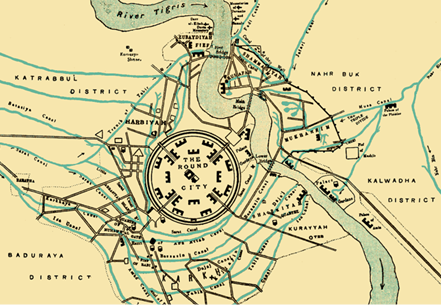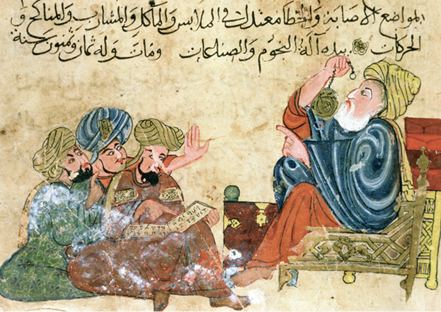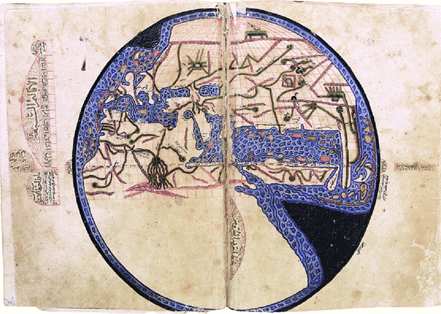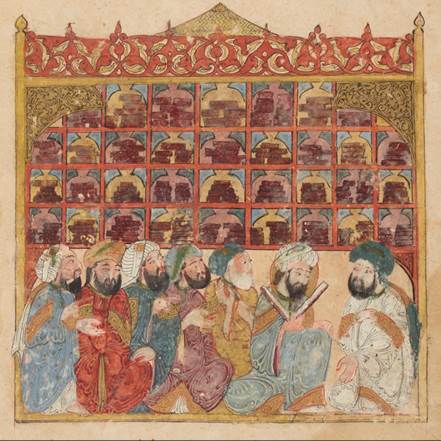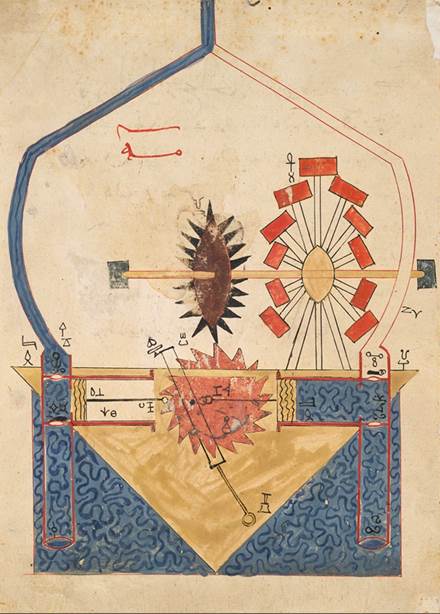After the collapse of the Roman Empire, Western Europe dropped into an age of darkness from which it would only recover in the High Middle Ages. Yet the intellectual tradition of Greece and Rome didn’t completely vanish. It moved eastward, to the Islamic world, where, from the eighth century, both art and science flourished, especially in Baghdad, which became the economic, cultural, and intellectual center of the world. We call this era the Islamic Golden Age.
During this time, scholars translated many Greek texts into Arabic, preserving them from extinction. But the Arabs did more than just preserve knowledge. They invented the rules of algebra, created sophisticated water-powered machines, improved the theory of optics, learned to distill alcohol, and much more. The intellectual tradition of the time also allowed for dissenting thought, including strong critiques of religion.
The Arabs also invaded and conquered Spain, forming the Caliphate of Cordoba, which allowed for cultural exchange between Islam and the West.
The expansion of Islam
The Arabian Peninsula was unified under the prophet Muhammad in the seventh century. His first successors (or “caliphs”) had all been close to Muhammad. The first caliph was his old friend Abu Bakr, then his close companions Umar and Uthman, and finally his adopted son Ali. Together, they formed the Rashidun (“rightly guided”) Caliphate (632–661). During their reign, the Muslims conquered the Persian Empire and also Egypt and Syria, which were part of the Christian Eastern Roman Empire (the Byzantine Empire). Contemporary Muslim historians name Jihad, or holy war, as the main impetus behind the expansion.
Muhammad had hoped Muslims would not fight amongst themselves, but even the election of the first caliph was controversial. Some Muslims preferred Abu Bakr, while others wanted Ali on the throne. This immediately caused a split in the Muslim community that persists to this day, dividing Islam into the Sunni and Shia branch.
The disagreement quickly led to the First Fitna, the first Islamic civil war. At the Battle of the Camel, Aisha, one of Muhammad’s wives, tried to take on Ali, but she was finally defeated by him. In 656, the son of Abu Sufyan, called Muawiya (d. 680), who had been one of Muhammad’s scribes, also took on Ali. Following the assassination of Ali in 661, Muawiya became the first caliph of the Umayyad Caliphate (661–750). Muawiya moved the capital of his new caliphate from Medina to the more cosmopolitan Damascus, in Syria. There, they bought the Basilica of St. John the Baptist, demolished it and built a mosque in its place, partly using the building materials of the church. Under Umayyad rule, the Muslim’s conquered western India and the nomadic Berbers in Northwest Africa (the so-called Maghreb). The Berbers, named after the Greek word “barbarian,” formed nomadic tribes. They were tough fighters, but the Arabs finally succeeded and the Berbers converted to Islam.
Al-Andalus
Not long after, the Muslims even conquered most of Spain. Already in the early 8th century, the Arabs, now with a Berber army, organized a number of raids into Spanish territory under the leadership of General Musa ibn Nusayr (c. 640–716). When one of the raiders came back with loot and with “female captives so beautiful as Musa and his people had never seen,” it convinced the general to organize a full-blown invasion. In 711, the Muslims invaded Spain with a Berber army led by General Tariq ibn Ziyad (c. 670–720). Tariq landed in Spain at a location they named the “Rock of Tariq,” or “Jebel Tariq,” which was later Westernized to “Gibraltar.” General Musa quickly followed with another army.
The Christian Visigoths of Spain were quickly overrun. Their king, King Roderic (d. 711), was slain and his capital Toledo was taken. According to the near-contemporary document, named The Chronicle of 754, a number of prominent people in Toledo were killed and the archbishop fled the city. And, indeed, we find the archbishop’s name among attenders of a church council in Rome.
The Jews of Spain chose the side of the Muslim invaders. This was because they had been treated horribly under the Visigoths. They were not allowed to hold public office, had to pay additional taxes, and were eventually forced to choose between baptism or slavery (although this wasn’t always successfully enforced). As the Muslims were in the minority in Spain, they placed various major cities (including Cordoba, Toledo, and Seville) temporarily in the hands of the Jews, while the Muslims continued their advance.
Following the precedent of their earlier Muslim conquests, Visigoth cities and towns were often given three options, which were dictated by Islam. They could either convert to Islam, surrender and pay an extra tax, or they could resist, in which case adult males were executed and women and children were enslaved. The extra tax mentioned here is called the jizya. According to the Quran, the point of this tax was to “subdue” or “humble” Jews and Christians. We read:
Fight those who do not believe in Allah or in the Last Day and who do not consider unlawful what Allah and His Messenger have made unlawful and who do not adopt the religion of truth from those who were given the Scripture—until they give the jizyah willingly while they are humbled [“made small”].
Those who surrendered were allowed to practice their religion, as Muhammad did not allow forced conversions. Yet they were only allowed to practice their religion in private. This included no visible religious symbols on the body and no crosses on churches and no church bells. Christians and Jews were also treated as second class citizens by Islamic Law. For instance, their punishments were higher and compensation for injury or death was lower. Paying the jizyah did buy Jews and Christians protection. As a result, they were called dhimmi meaning “protected people.”
Although they were never forced to convert, these laws did put social pressure on Christians and Jews to become Muslim. Cleverly, Islamic Law dictates that a Muslim man was allowed to marry a Christian woman (and their children had to be Muslim), but a Christian men who married a Muslim woman had to be killed. This funneled all intermarriages in favor of Islam. On top of this, conversions in the other direction were actively discouraged. Muslims who secretly practiced another religion were killed without an opportunity to repent. Open apostates were given a chance to return to Islam, yet if they refused or reoffended, they too were killed. As a result of all this, the Christian population steeply declined over the centuries. It has been estimated that by the year 1000, 75% of the population of Spain was Muslim. [190]
Yet, as we shall discuss later on, Jews and Christians were allowed to climb up the social ladder, and were even allowed to occupy important positions in government, including vizier. And over time, many Christians came to have deep respect for the Muslims, who were at the time more advanced, both culturally and intellectually, compared to early medieval Europeans.
Not long after his arrival, General Musa was recalled to Damascus, taking with him Spanish captives and booty:
All the spoils […] consisted of 30 skins full of gold and silver coins, […] peals, rubies, topazes, and emeralds, […] costly robes, […] 1100 prisoners, men, women, and children, of whom 400 were princes of royal blood. [191]
According to The Chronicles, the Muslims controlled most of Spain within ten years, including Septimania in southern France.
The estates of the Spanish monarchy came in Muslim hands and were distributed among the Arab elites. They Berber majority, who had risked their lives for the Arab cause, got little. They were often considered second class citizens. Tired of this, the Berbers rebelled in 739, both in the Maghreb and in Spain. The Umayyads managed to retain Spain, but lost Western Maghreb.
Charles Martel
A decade after the invasion of Spain, the Muslims also began a series of raids into France. At the time, most of France was formally governed by the Frankish Merovingian kingdom, yet true power was in the hands of the so-called Mayors of the Palace. Pepin of Heristal (c. 635–714) was the first mayor to become the de facto ruler of France, followed by his son, Charles Martel (c. 688–741). Martel means Hammer, for, it was said about him, “as a hammer breaks and crushes iron, steel and all other metals, so did he break up and crush his enemies.” The southwest of France, called Aquitaine, was at that time independent and ruled by King Odo (d. c. 740).
The first large invasion of France was led by General Abd al-Rahman al-Ghafiqi (d. 732), who was a close friend of one of the sons of Umar, the 2nd Rashidun caliph. His name first appears in the written sources during a siege of Toulouse in 721, from which he had to retreat in defeat. Ten years later, in 731, another army entered France (led by another general). It burned and looted many France cities, including Lyon. According to Christian sources, men were slaughtered while women and children were taken as slaves. Various monasteries were also looted and destroyed. The army reached all the way to Sens, not far from Paris. Here, a bishop named Saint Ebbon, who was a retired soldier, organized a successful defense. As a result, the raiders retreated. [192]
In 732, al-Ghafiqi invaded France as second time. Among the volunteers for his army were a great number of Berbers, who were hungry for booty. They entered France on the west side, in Aquitaine, in King Odo’s domain. Again, they destroyed villages and burned and looted abbeys.
Their main force then headed for Bordeaux. According to The Chronicle of 754, King Odo engaged the Muslims in battle to defend Bordeaux, but was defeated, although a substantial part of his army managed to escape. Once in Bordeaux, the Muslims burned churches, killed many citizens, including the governor, and took substantial loot. The armies met once more near Agen, where King Odo was again defeated. He then fled to Paris, where he asked Charles Martel for help. Charles agreed to help out and started raising a large army. In the next three months, the Muslims raided Aquitaine without resistance. Many cities were sacked, including Perigueux. They then moved to Poitiers. There, they sacked the abbey of Sainte-Hilaire, located outside the city, but they decided to leave the city alone. They then moved to Tours, in the Frankish kingdom. There, they attacked the abbey-church of Saint-Martin, just outside Tours, but again they did not attack the city. [192]
They then returned in the direction of Poitier, where Charles caught up with them. The armies met 20 kilometers from Poitier and readied themselves for a major battle, the Battle of Poitier. Charles’s army crossed the Vienne and then took a defensive position with its flanks anchored by forests.
Most sources agree that the Muslims made the first assault. Charles then countered and also had a small part of the army detour around the forest, allowing them to attack the Muslim camp, forcing the army back to defend their tents. During the fighting that ensued, Abd al-Rahman was mortally wounded. Aware they were losing, the Muslims cleverly withdrew at night, leaving their tents, their booty, and their prisoners behind, causing the Franks to believe they were still in position. When Charles was ready to attack the camp during the day, he found it abandoned. Charles Martel then returned to his kingdom, while King Odo chased the retreating Muslims out of France.
Isidore, the bishop of Beja, writing about the event on the Muslim side, described the Battle of Poitier as an indecisive battle, with few losses compared to the Muslim defeat at Toulouse. In The History of the Lombard, on the Christian side, however, we read that the Muslim losses were massive, with few losses on the Christian side. Whatever was the case, Charles Martel and his successors received great international prestige for their victory against the Muslims. The Battle of Poitier even evolved into an epic in which Charles was portrayed as the savior of European Christendom against the forces of Islam.
After the defeat at Poitier, the Muslims were still in charge of Septimania, in Southern France, including its capital Narbonne. Charles’s son Pepin finally chased the Muslims out of Septimania in 759. Pepin’s son Charlemagne took on the Muslims in Spain in 778, but this failed. The Franks got defeated and on their home journey, the rearguard of their army was attacked by the Basques, causing the death of Charlemagne’s vassal Roland, as memorialized in the Chanson of Roland.
The later Abbasid Caliphate would also enter Southern Italy, where they managed to take over a few cities for a couple of decades. In 846, they even sacked Saint Peter’s Basilica in Rome, but were unable to breach Rome’s city walls. And they also took Sicily between 831 and 1091.
The House of Wisdom
Because of their rapid expansion, the Arabs quickly became a minority in their own caliphate, allowing for much cultural exchange. The Muslims eagerly made use of the expertise of the peoples they conquered, including the Persians, Jews, Christians, and Indians. This was necessary for them to successfully set up their new empire, given that they only recently came out of a tribal and often nomadic lifestyle (which Muhammad called jahiliyyah, referring to the “barbaric” ways of pre-Islamic Arabia). In the words of the Muslim historian Ibn Khaldun:
The Arabs [at this time] were coarse, without education, and not very skilled in the arts of writing and mathematics. Thus, they used the Jews, Christians, and freed foreigners to handle their administrative affairs, […] the Arabs barely coming out of their nomadic existence. [191]
The Umayyad royalty also wanted to construct great architecture for their empire and had gained a genuine interest in philosophy, mathematics, astronomy, medicine, optics, chemistry, and many other intellectual disciplines, which also required the help of these other cultures, who had centuries of expertise in these domains. In their capital, Damascus, the Umayyads created the first Arabian palace library, collecting Greek and Christian works on alchemy, medicine and other sciences.
It wasn’t until 750, however, that the Islamic Golden Age truly took hold. In that year the Abbasid Caliphate, characterized by its black banners, under the leadership of As-Saffa (c. 721–754), overthrew the Umayyad Caliphate.
The first Abbasid caliphs were aided by the vizier Khalid ibn Barmak (708–782), who was a member of a powerful family whose ancestors had been leaders of a Buddhist temple in Afghanistan, but later converted to Islam. Khalid, and later his son and grandson (who became viziers under later caliphs), became important patrons of the sciences. The family is credited with helping introduce Indian science to the Muslim world and also with the establishment of the first water-powered paper mill in Baghdad (paper was brought in from China in 751, after the Abbasids successfully defeated a Tang Dynasty army in western China).
The Abbasid Caliphate was properly stabilized during the reign of As-Saffa’s brother, al-Mansur (753–774). He hunted down the last remaining members of the Umayyad family. The only significant figure to escape was Abd al-Rahman (731–788), who fled to Spain, where he started a successful independent Islamic state (which we will discuss later in this chapter).
In 762, al-Mansur was looking for a new capital. Instead of Arab-dominated Damascus, he moved closer to Persia, where the Abbasids had their most loyal supporters. Khalid ibn Barmak helped al-Mansur find the site of his new capital, with access to both the Tigris and the Euphrates. He named the city Madinat al-Salam (the City of Peace), yet the name that finally took hold was the name of the old Persian settlement that had been located on the same spot—Baghdad (meaning “Founded by God” in Old Persian). Baghdad was also called the Round City because of its circular shape. The city was surrounded by circular double city walls with four domed gates and a moat. The caliph’s palace, the royal mosque, and various government offices were placed at the center of the city. In the suburbs outside the rings, Caliph Al-Mamun would later build an observatory.
In time, Baghdad became the largest city in the world, peaking at an estimated population of a million people. According to the historian Al-Khatib al-Baghdadi (1002–1071), its main palace had magnificent marble columns and was filled with horses with gold and silver saddles, elephants, lions, golden boats, exotic trees, fire hurlers, and more. There was also a tree with golden branches with mechanical golden birds that could whistle.
Fig. 361 –The Round City of Baghdad, by William Muir (1883 AD)
In 771, an embassy of Indian scholars brought over a copy of the Brahmasphutasiddhanta, an important work by the great Indian mathematician Brahmagupta (c. 598–668). This work taught the Arabs how to use the sine function, and to calculate with negative numbers, and with the number zero (more on this later). It was a tough read, as most early Hindu scientific texts do not give proofs and offer few explanations (they were also often written in verse for easy memorization, which also didn’t improve the clarity of the texts). The Indians also brought over a collection of over a hundred tables on the movement of the heavenly bodies, which the Arabs called the zij al-Sindhind. The work used the Indian city of Arin as its reference point for observation, but this was later translated to Baghdad.
The Islamic Golden Age truly picked up steam under the leadership of caliph Harun al-Rashid (c. 766–809) and his son Al-Mamun (786–833). Both had a great love for philosophy (falsafa), especially when it came from ancient Greece. Because of his study of Greek texts, Al-Mamun became convinced of the power of reason to comprehend the universe. This revelation supposedly came to him in a dream in which he met Aristotle and asked him “What is the good?” He received the reply: “Whatever is good according to reason.” He then asked what comes second. Aristotle responded: “Whatever is good according to religious law.” Third came “the opinion of the masses.” [193] We are told he woke up with the conviction that reason and revelation were not in conflict. This was in direct opposition to orthodox Islam, which holds that revelation from God is the only true source of knowledge. Al-Mamun’s opinion was closely aligned with a new branch of Islam called Mutazili, which shared his appreciation for reason. Feeling there was no place for the old conception of Islam, he gave orders to persecute anyone who refused to accept his rationalistic approach. His sentences ranged from imprisonment to beheading.
Fig. 362 – Aristotle depicted as a Muslim holding an astrolabe while teaching students (13th century) (Topkapi Palace Museum, Turkey)
Fig. 363 – A copy of al-Mamun’s 9th century world map by al-Umari. The image here is displayed upside down, since the Arabs used to make world maps with the south side up (c. 1340 AD) (Topkapi Palace Museum, Turkey)
Fig. 364 – A copy of Roger II’s world map by al-Idrisi (1154 AD); Bodleian Library
Al-Mamun’s wide interest in knowledge also showed when he commissioned a world map, combined with extensive descriptions of the world’s cultures. A 14th century copy of the map is still available (see Fig. 363). The accompanying text mentions 530 cities and among a number of “famous and marvelous things” it mentions the Great Wall of China. [194] A later 12th century map by al-Idrisi (1100–1165) was made for the Norman king Roger II (1095–1154) who ruled Sicily and had a love for both Greek and Arabic knowledge. This map was even more impressive, stretching all the way from Korea to the Canary Islands (see Fig. 364). The original, now lost, was supposedly etched on a silver disk.
The most important contribution of al-Rashid and al-Mamun to the intellectual tradition of the Islamic Golden Age was their creation of the House of Wisdom (bayt-al-hikma). The project began as a private library under al-Rashid, which Al-Mamun subsequently turned into an international center for learning by bringing in many respected scholars from around the empire. Cleverly, Al-Mamun didn’t just hire Muslim scholars, but also included Jews, Christians, and Zoroastrians. This was essential for its success, since the Arabs at that time were far behind in the sciences.
Fig. 365 – Scholars at an Abbasid library in Baghdad, from The Maqamat (1237 AD) (Bibliotheque Nationale de France)
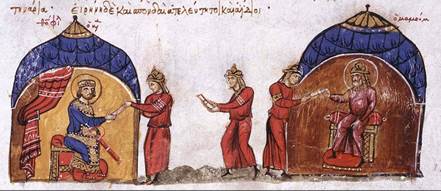
Fig. 366 – Abbasid Caliph Al-Mamun sending an envoy to the Byzantine Emperor Theophilos (History of Byzantium, 11th century)
The initial goal of the movement was to bring in all books of intellectual worth from the surrounding cultures and to translate them into Arabic. It is said that, at one point, Al-Mamun sent a camel caravan back from northern Persia with a hundred animals just to carry manuscripts. He also managed to obtain a copy of the Almagest—Ptolemy’s groundbreaking work on the solar system—as part of a peace treaty with the Byzantine Empire.
The translation movement gave Muslims access to the knowledge of the ancient world and also preserved many Greek texts that would have otherwise been lost forever. Among them were works of Aristotle and Galen. The 12th-century Renaissance in Europe was, in large part, sparked by the retranslations of these works back into Latin.
As literacy rates were still extremely low, being a translator was a prestigious and well-paid job. Translators could expect to get paid the weight of each translated text in gold. Al-Kindi (c. 801–873), who also headed one of the teams in the House of Wisdom, was one of the most important translators. He was also a great mathematician, alchemist, physician, and musician and left around 230 original works. He was also the first to distill alcohol, which he described in his book The Alchemy of Perfume and Distillation. Al-Kindi belonged to a group of free thinkers who believed knowledge should be appreciated regardless of its religious or cultural origin:
We must not be ashamed to admire the truth or to acquire it, from wherever it comes. Even if it should come from far-flung nations and foreign peoples, there is for the student […] nothing more important than the truth, nor is the truth demeaned or diminished by the one who states or conveys it […]. Rather, all are ennobled by it. [40]
By reading the Quran not literally but allegorically, al-Kindi attempted to resolve the conflict between the Quran and Aristotelian philosophy, between faith and reason. To him, the pursuit of truth was yet another pathway to God.
Characteristic of the spirit of his time, Al-Kindi was a very bold and confident intellectual. According to one story, he visited a scholarly debate at which the caliph Al-Mamun himself was present. Al-Kindi, still a young man, took a seat very close to Al-Mamun, even closer than an older, more prominent theologian. The older man was offended and asked why he thought he could sit so close to the caliph. Al-Kindi responded:
Because I know what you know, but you don’t know what I do. [195]
The most prolific translator was the Christian scholar Hunayn Ibn Ishaq (808–873 AD), who was both Al-Mamun’s doctor and head of translation in the House of Wisdom. He translated over a hundred works, including Plato’s Timaeus, Aristotle’s Metaphysics, and the Old Testament. Together with his son, he also translated various works by Galen. He developed a whole new vocabulary to allow scientific ideas to be expressed in Arabic and also improved translation methods by focusing more on the underlying message conveyed by the text and not just on a literal translation of words. He also compared different versions of the same book in order to reconstruct the most authentic version. As a result, his translations often became standard versions, which were later translated back into Latin.
The polymath Ibn Sina
But the Islamic Golden Age did more than just copy and preserve information. It added a wealth of original works in the branches of science, mathematics, astronomy, medicine, geology, metallurgy, engineering, technology, and almost every other branch imaginable.
Many of the greatest minds of the Islamic Golden Age were polymaths. Among the most influential among them was Ibn Sina (980–1037), westernized in the Middle Ages as Avicenna, who wrote on philosophy, medicine, astronomy, alchemy, geography, theology, logic, mathematics, physics, poetry, and more. He wrote approximately 450 titles, of which more than half survive. His Canon of Medicine became the standard medical textbook of the medieval world and was still used in European universities as late as the 17th century. His Book of Healing deals not with medicine, but rather with how to cure an ignorant soul. It is concerned with logic, science, mathematics, and metaphysics. In this work, he described his famous thought experiment called the floating man. We read:
Imagine a human is created at an instant, with his limbs separated and he does not see them, he cannot touch them, and they do not touch each other, and he hears no sound, he would be ignorant of the existence of the whole of his organs, but he would know the existence of his individual being as one thing, while being ignorant of all the former things. [196]
Ibn Sina hypothesized that a person in this state, without memory or sensory data, would still know of his existence. In his view, this pointed to the existence of a self-aware soul distinct from the body.
Ibn Sina’s reliance on logic led him to the heretical view that God knows nothing about human history. Following Aristotle, he claimed that God was the driving force behind the motion in the universe, but that he did not know about individuals or particulars.
Ibn Sina also wrote a short autobiographical work, in which he recorded his achievements with a sense of confidence typical of the great thinkers of the Islamic Golden Age. He boasted that he read the Quran and many other works of literature by the age of ten.
While studying Aristotelian logic, he quickly outsmarted his master:
He was extremely amazed at me; whatever problem he posed I conceptualized better than he, so he advised my father against my taking up any occupation other than learning. I continued until I had read the simple parts of logic under him; but as for its deeper intricacies, he had no knowledge of them. So I began to read the texts and study the commentaries by myself until I had mastered logic. As for Euclid, I read the first five or six figures under him; then I undertook the solution of the rest of the book in its entirety by myself. Then I moved on to the Almagest [Ptolemy’s work on the solar system]. [196]
Afterward, Ibn Sina spent a year and a half doing nothing but learning and reading, working till late at night:
At night I would return home, set out a lamp before me, and devote myself to reading and writing. Whenever sleep overcame me or I became conscious of weakening, I would turn aside to drink a cup of wine, so that my strength would return to me. Then I would return to reading. And whenever sleep seized me I would see those very problems in my dream; and many questions became clear to me in my sleep. I continued in this until all of the sciences were deeply rooted within me and I understood them as far as is humanly possible. Everything which I knew at that time is just as I know it now; I have not added anything to it to this day. [196]
When Ibn Sina cured a sultan, he was enrolled in his service. One day, he asked permission to go to his library, and this is what he saw:
He gave me permission and I was admitted to a building which had many rooms; in each room there were chests of books piled one on top of the other. In one of the rooms were books on the Arabic language and poetry, in another, on jurisprudence, and likewise in each room [were books on] a single science. So I looked through the catalogue of books by the ancients and asked for whichever one I needed. I saw books whose names had not reached very many people and which I had not seen before that time, nor have I seen since. I read these books and mastered what was useful in them and discovered the status of each man in his science. So when I had reached the age of eighteen I was finished with all of these sciences. [196]
Al-Khwarizmi and the discovery of algebra
One of the most important mathematicians of the Islamic Golden Age was al-Khwarizmi (c. 780–850), who made lasting contributions to the field of algebra. Algebra refers to the process of manipulating equations to find the value of unknown variables (in high school, this often boils down to “finding the x”).
The Babylonians
had already found solutions to various equations (including quadratic
equations), but algebra truly took off when the Greek mathematician Diophantus
of Alexandria (3rd century AD) wrote a work called Arithmetica,
in which he studied a long list of number problems and gave their solutions. Ahead
of his time, Diophantus also used mathematical symbols to concisely
describe mathematical operations and unknown variables (for instance, he used “![]() ” for subtraction
and “ζ” for an unknown quantity). Diophantus’s work, however, still had some shortcomings.
For instance, he did not consider zero and negative numbers valid solutions to
his equations (he even called them “absurd”). This was because the Greeks
equated numbers with the length of lines and lines with zero or negative length
do not exist. Diophantus also solved every specific problem on its own, instead
of finding generalized algorithms to solve a whole host of equations.
” for subtraction
and “ζ” for an unknown quantity). Diophantus’s work, however, still had some shortcomings.
For instance, he did not consider zero and negative numbers valid solutions to
his equations (he even called them “absurd”). This was because the Greeks
equated numbers with the length of lines and lines with zero or negative length
do not exist. Diophantus also solved every specific problem on its own, instead
of finding generalized algorithms to solve a whole host of equations.
The next great developments in algebra came from India. In the 7th century, Brahmagupta (c. 598–668) allowed for negative solutions to equations. Brahmagupta was also the first person (as far as we know) to use the number zero in calculations. The Babylonians had used the zero only as a placeholder, leaving a space open for zero when writing down large numbers. The Egyptians did have a symbol for zero (“nfr”), which they used in bookkeeping to denote “no money” and in architecture to denote the ground level (the layers of stones of a pyramid were counted in “cubits above nfr”). Different from these earlier uses, Brahmagupta used the zero not just as a placeholder or a symbol for “nothing,” but as a number to be used in calculations in its own right. He also gave the rules for calculating with zero. For instance, we read:
The product of a negative and a positive is negative, of two negatives positive, and of positives positive; the product of zero and a negative, of zero and a positive, or of two zeros is zero. [197]
The Indian word for zero, “sunya,” meaning “empty,” became “sifr” in Arabic, from which our word “zero” is derived.
Al-Khwarizmi finally transformed algebra into a mature subject in The Compendious Book on Calculation by Completion and Balancing, which he wrote with the encouragement of the caliph Al-Mamun. Instead of simply giving solutions to specific problems at hand, as Diophantus had done, al-Khwarizmi set out to systematically and exhaustively solve general equations. He solved quadratic equations by dividing them into six classes and offering systematic steps to solve each of these cases. Today such a procedure is called an algorithm, named after al-Khwarizmi.
To solve these equations, al-Khwarizmi used two operations which were already recognized by Diophantus, but now received their own names: al-jabr (“completion”) and al-muqabala (“balancing”). Al-jabr, which in Europe turned into the word “algebra,” was the process of moving terms from one side of the equation to the other. Al-muqabala was the process of canceling equal terms that appear on both sides of the equation.
Algebra wasn’t al-Khwarizmi’s only contribution. In his book On the Calculation with Hindu Numerals, he introduced the Indian numeral system to the Arabic world, which is the decimal number system we still use today. This system had been developed in India somewhere in the first centuries AD and was much more convenient to use than Roman numerals. Compare, for instance, the Roman number MCMLXXXVII with the modern notation 1987. In al-Khwarizmi’s words:
We have decided to explain Indian calculating techniques using the nine characters and to show how, because of their simplicity and conciseness, these characters are capable of expressing any numbers. [194]
Al-Khwarizmi also included the zero, which he called “the tenth figure in the shape of a circle.”
Arab mathematicians also greatly extended the field of trigonometry, which also had its earliest foundations in ancient Greece. Already in 140 BC, the Greek astronomer Hipparchus produced a table of chords, an outdated equivalent of the sine function, which is useful for describing the motion of objects moving on a circular arc, such as the heavenly bodies. A table for the sine function appeared in an anonymous Indian astronomy text known as the Surya Siddhanta (505 AD). The Arabs made important discoveries regarding triangles on spherical surfaces, which was partly motivated by a wish to better calculate the direction of prayer, the qibla, from anywhere on earth. This was first done accurately by al-Biruni (b. 973), who in his The Determination of the Coordinates of Cities used spherical trigonometry to calculate the direction of Mecca from a city in Afghanistan.
Al-Haytham and the discovery of the scientific method
One of the greatest scientists of the Islamic Golden Age was Ibn al-Haytham (c. 965–1040), whose name was westernized to Alhazen in the Middle Ages. He wrote about 100 works on mathematics, astronomy, meteorology, optics, and many other topics. His most famous work is his Book of Optics, which changed our understanding of light and vision. In this book, we read about lenses, mirrors, errors in visual perception, refraction, and more.
His most important discovery was his solution to a problem concerning vision that had existed since ancient Greece. In Greece, there had been two theories about light and vision. The first theory was the emission theory, which held that vision functioned because the eye emits rays of light. This might sound a bit ridiculous to the modern reader, but it was supported by great thinkers such as Euclid and Ptolemy. Euclid believed that rays were emitted from the eye in the shape of a cone. Since the radius of the cone becomes larger with distance, this allowed him to understand why objects looked smaller when they are further away—it explained perspective. The atomists of Greece didn’t agree. They thought that all objects emitted atoms and that these atoms made visible images when they entered our eyes. Yet that model could not explain how the atoms from an entire mountain could all fit in someone’s eye. The atomists also couldn’t explain how objects could continuously send out atoms without reducing in size.
Ibn al-Haytham refuted Euclid’s theory with a simple thought experiment. Imagine raising your head to the night sky with eyes closed. When you open your eyes, the stars immediately become visible. In Euclid’s theory, this would mean that the rays would instantly fill the entire universe, which is nonsensical. Nevertheless, Ibn al-Haytham did see the advantages of Euclid’s cone theory, since it explained perspective. His solution was to assume sunlight reflects against objects and then enters the eye in the same cone shape. This is the theory still in use today.
Despite this breakthrough, Ibn al-Haytham still couldn’t explain how light rays, coming from all directions and from objects big and small, can form sharp images inside our eyes. He erroneously guessed that the eye only perceives rays that entered our eyes perpendicularly. This problem was later solved by Johannes Kepler in the 17th century, who was the first to give a correct description of lenses.
Al-Haytham’s book on optics is also important for another reason. The work reads like a scientific text beyond anything written until that point in world history. While most Greeks (except for Aristotle and Ptolemy) saw no problem accepting clever-sounding theories without any empirical evidence, Al-Haytham only presented his theories after sufficient measurements had shown them to be demonstrably true. From the first pages of his work, al-Haytham proceeded in small careful steps, sticking close to sensory evidence. Even more so than the Optics of Ptolemy, the work is packed with experimental demonstrations, including step-by-step description of experimental setups, allowing the reader to confirm every step along the way.
Crucially, Al-Haytham also used language to indicate the use of experiments as opposed to passive observation (as had been Aristotle’s preferred method). For instance, he used the word “I’tibar”—which medieval Europeans translated to “experimentum.”
Al-Haytham’s own descriptions of his methodology are also surprisingly modern. He acknowledged the difficulty of gaining accurate knowledge and the fallibility of human thinking:
Certainty is difficult to achieve! For the truths are obscure, the ends hidden, the doubts manifold, the minds turbid, the reasonings various; the premises are gleaned from the senses, and the senses (which are our tools) are not immune from error. […] The inquirer, however diligent, is not infallible. [198]
The only way out of this, he claimed, is by grounding our theories with sensory data and by criticizing our own work relentlessly:
To find the truth is hard and the way to it rough. For the truths are immersed in uncertainties, and all men are naturally inclined to have faith in the scientists. […] But God has not protected scientists from error, nor has He made their science immune from shortcomings and defects. Had this not been the case, they would not have disagreed about anything in the sciences, nor would their opinions have differed in regard to the true nature of things. But the facts are otherwise. The seeker after the truth is not one who studies the writings of the ancients and, following his natural disposition, puts his trust in them, but rather the one who suspects his faith in them and questions what he gathers from them, the one who submits to argument and demonstration, and not to the sayings of a human being whose nature is fraught with all kinds of imperfection and deficiency. Thus, the duty of the man who investigates the writings of scientists, if learning the truth is his goal, is to make himself an enemy of all that he reads, and, applying his mind to the core and margins of its content, attack it from every side. He should also suspect himself as he performs his critical examination of it, so that he may avoid falling into either prejudice or leniency. [199]
In his book on light, he warned against “believing in Ptolemy’s words in everything he says, without relying on a demonstration or calling on a proof.” He added:
That is how experts in the prophetic tradition have faith in prophets, may the blessing of God be upon them. But it is not the way that mathematicians have faith in specialists in the demonstrative sciences. [200]
Ibn al-Haytham is also said to have tried to introduce a hydraulic system into the Nile to regulate its annual flooding. When his plan failed, he had to fear for his life since the caliph of Egypt, nicknamed Hakim the Mad (985–1021), had a violent temper. To save his life, al-Haytham decided to pretend he had gone mad. The plan worked, although he did have to spend the rest of his life under house arrest. At home, surrounded by his library, he wrote his most important scientific works.
Another early scientist worth noting is al-Fasiri (1267–1319), who in a commentary on al-Haythams Optics gave a description of the rainbow. He demonstrated his theory by studying how light refracts and reflects against a glass sphere filled with water, which he used as a model of a small water droplet in the atmosphere. The use of models to answer scientific questions became one of the hallmarks of science.
Medieval machines
The Arabic engineers of the Islamic Golden Age excelled at creating revolutionary machines. In 803, a delegation of Arabs arrived in Germany to meet with King Charlemagne (748–814). The delegation brought various gifts from Harun al-Rashid, among them an elephant and a water clock that chimed every hour. Never having witnessed anything like this before, the Europeans at Charlemagne’s court thought the device operated on satanic magic, but after inspection, they concluded:
[It is a] marvelous mechanical contraption in which the course of the twelve hours moved according to a water clock, with as many brazen little balls, which fell down on the hour and through their fall made a cymbal ring underneath. On this clock there were also twelve horsemen who at the end of each hour stepped out of twelve windows, closing the previously open windows by their movements. [201]
These inventions were inspired by the works of Hero of Alexandria (1st century AD), who wrote several books on machines, including Pneumatica and Automata, in which he described machines working on air, steam, and water pressure. In these books, he describes a steam engine, an automatic water organ, automatic opening and closing temple doors, and a statue that serves as a vending machine, pouring holy water after accepting a coin. Some of these inventions, including the water organ and the steam engine, are attributed to an even earlier inventor named Ctesibius (3rd century BC), whose works are now lost.
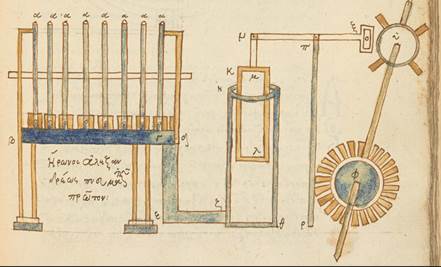
Fig. 367 – A wind-powered organ from a 16th century copy of Pneumatica by Hero of Alexandria.
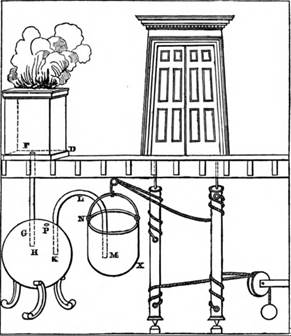
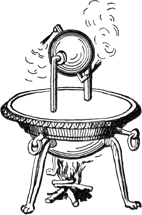
Fig. 368 – A modern depiction of Hero’s automatic doors, from The Pneumatics of Hero of Alexandria (1851) A chamber of air (upper left) is heated, pushing water from the circular tank (H) into a bucket (M). The weight of the water pushes the bucket downward and opens the door. When the air cools off again, the process reverses itself.
Fig. 369 – A modern depiction of Hero’s steam engine, from Knight's American Mechanical Dictionary (1876). Water in the tank below is heated and propels from the tubes at the top in the form of steam, causing the orb at the top to rotate.
The Banu Musa brothers (9th century) were the most famous engineers of the early Islamic Golden Age. In their Book of Ingenious Devices, we find designs for more than a hundred machines. We read of automatic water fountains that spouted alternating patterns of water, a hydraulic organ, and a pneumatic flute that could play various tunes. Most of these machines were useless curiosities, but there were some exceptions, such as a grabber used to remove muddy deposits in water, a simple gas mask, a windproof torch, and a spillproof jar.
Another great inventor was al-Jazari (1136–1206), who designed a number of robots, for which he has been called the father of robotics. His inventions are collected in his work The Book of Knowledge of Ingenious Mechanical Devices. Among his automatons, we find a hydraulic peacock. Pulling a plug on the peacock’s tail released water out of its beak, which could be used to wash hands. The used water then caused a float to rise, which activated a linkage to make a servant figure appear from behind a door who offered soap. When more water was used, a second float caused the appearance of a second figure with a towel.
Fig. 370 – The Elephant Clock from The Book of Knowledge of Ingenious Mechanical Devices by al-Jazari (MET, United States)
One of his most ingenious designs was his elephant clock (see Fig. 370). The timing mechanism of the clock was based on a water-filled basin hidden inside the elephant. A deep bowl floated on the water, but with a small hole in the bottom. The bowl took half an hour to fill through this hole. As it sank, the bowl pulled down a string attached to a see-saw mechanism in the tower on top of the elephant. This released a ball that dropped into the mouth of a serpent, causing the serpent to tip forward, which pulled the sunken bowl out of the water via strings, allowing it to empty. At the same time, a number of strings caused a figure in the tower to raise his hand and the elephant driver to hit a drum every half hour. The cycle then repeated itself for as long as balls remained in the upper reservoir to power the emptying of the bowl.
Al-Jazari also invented several machines for practical use. For instance, he made a hydraulic pump, which could raise water to a higher level (see Fig. 371). The pump was powered by a water wheel, which was set in motion by the flow of water in a river. This wheel caused a pair of copper pistons to move in a pipe, which created suction to draw water upward. A number of valves kept the water from flowing back down. This is the oldest working example of double-action piston motion, putting al-Jazari hundreds of years ahead of his time.
Fig. 371 – A double-piston hydro-powered pump from the same book. The wheel in the middle moves two horizontal pistons in and out, sucking up water. Two valves on each side allow the water to go upward, but close off when the water starts pushing back down (Harvard Art Museum, United States)
Al-Jahiz, writer and evolutionist
One of the greatest writers of the Islamic Golden Age was al-Jahiz (c. 776–869). Al-Jahiz lost his father at a young age, which led to financial problems in his family. His mother did manage to enroll him in a local Quran school, where he learned to read and write. During this time, he discovered his love for books and knowledge. After school, he often attended lectures, where he became especially fascinated by discussions on the Arabic language. His mother encouraged his interests by buying him a box of notebooks and telling him he could make a living as a writer.
When he was 40 years old, al-Jahiz moved to Baghdad. Word of his talent soon reached Caliph Al-Mamun, who summoned him to his royal court. The caliph wanted to interview al-Jahiz to see if he would be a good tutor for his children, but they were scared of his bulging eyes (al-Jahiz is actually a nickname meaning “boggle-eyed”). Despite this setback, his professional reputation quickly grew, earning him enormous fame and fortune.
Al-Jahiz primarily wrote fiction. As a satirist, he mocked almost anyone, especially those who saw themselves as superior to the masses, including theologians, intellectuals, and politicians. Even the titles of his books are entertaining. One of them is called The Art of Keeping One’s Mouth Shut. One of his most famous works is The Book of Misers, which is a collection of satires on the rich and powerful.
Al-Jahiz also wrote scholarly material about rhetoric, linguistics, zoology, politics, and religion. On matters of religion, he argued for a greater reliance on reason. In his works on animals, al-Jahiz described some early ideas about evolution. Although the idea that one organism could descend from another dates back to ancient Greece, al-Jahiz went further by mentioning natural selection as a possible mechanism behind evolution. He hypothesized that animals engage in a struggle for existence and that only the surviving animals breed and pass on their successful characteristics to their offspring. He also hypothesized about the impact of the environment and climate on organisms. Perhaps, he reasoned, the color of different animals could be explained by environmental factors rather than by the will of God.
Al-Jahiz wasn’t the only Arab to consider evolution. Centuries later, Ibn Khaldun (1332–1406) asserted that humans developed from “the world of the monkeys.” [202] Al-Tusi (1201–1274) believed that the elements evolved into minerals, then plants, then animals, and finally into humans.
Al-Jahiz died when a tower of books fell on him in his private library at the age of 92.
Abu Nuwas, poet and provocateur
Abu Nuwas (c. 750–810) was one of the great poets of the Islamic Golden Age and a personal friend of Caliph Harun al-Rashid. Although he was greatly admired in his time, he also often got himself into trouble because of his explicit sexual references. He even wrote poems celebrating masturbation, sex with young men, wine, and drunkenness:
Cursed and poor is every hour that sober I must go. [203]
His controversial behavior wasn’t just confined to his writing. He was known for public drunkenness and often disrespected authority. On various occasions, even his friend al-Rashid couldn’t stand him any longer and threw him in jail. When in prison, he wrote poems offering his apology and promising to change his ways:
Do you want to see a miracle? Then set me free, and see how often I flatter God. Oh! I’ve been in jail too long and happiness can only come from your generosity. [204]
Abu Nuwas also frequently offended religious authorities with his fearless critiques of religion. About the Quran, he wrote:
I love whatever the Book forbids. And run from whatever it allows. [204]
Because of his behavior, Abu Nuwas was eventually exiled. He was only allowed to return after Harun al-Rashid had died, when Al-Mamun invited him back.
Critiques on religion
Another fearless critic of religion was the poet and philosopher al-Ma’arri (973–1057). He wrote:
The world is divided into two types of men: Those who have intelligence and no religion and those who have religion and no intelligence. [204]
Al-Ma’arri rejected divine revelation and instead preferred reason as a pathway to truth. He also described religion as a “fable invented by the ancients.” He wrote:
Do not suppose the statements of the prophets to be true; they are all fabrications. [...] The sacred books are only such a set of idle tales as any age could have and indeed did actually produce. [205]
Another strong critic of religion was al-Razi (854–925), who was also the greatest physician of medieval Islam. He wrote a vast encyclopedia on medicine, was the first to describe the difference between smallpox and measles, and helped found hospitals in Baghdad. He also kept records of medical interventions to see how effective they were (in one case with a sample of 300 and in another with 2000 patients) and in one instance he used a control group to “remove doubt” about the effectiveness of his treatment.
On the question of religion, he presumably called the Quran “a work which recounts ancient myths” and believed that the common people had been duped into belief by religious authorities, who had no interest in challenging their received wisdom with rational analyses. He also remarked on the intolerance of religious dogma:
If the people of this religion are asked about the proof for the soundness of their religion, they flare up, get angry, and spill the blood of whoever confronts them with this question. They forbid rational speculation, and strive to kill their adversaries. This is why truth became thoroughly silenced and concealed. [206]
Al-Razi is also said to have written a number of heretical books. The book On Prophecies was an attack on religion, and the book On the Tricks of False Prophets was an attack on the validity of prophets. Unfortunately, these books have not survived. However, we do have a summary of a debate between al-Razi and one of his critics, written by his opponent. In the debate, al-Razi rejected the idea that the Quran itself was evidence for the existence of God:
You claim that the evidentiary miracle is present and available, namely, the Quran. You say: “Whoever denies it, let him produce a similar one.” Indeed, we shall produce a thousand similar, from the works of rhetoricians, eloquent speakers, and valiant poets, which are more appropriately phrased and state the issues more succinctly. They convey the meaning better and their rhymed prose is in better meter. [...] By God what you say astonishes us! You are talking about a work which recounts ancient myths, and which at the same time is full of contradictions and does not contain any useful information or explanation. Then you say: “Produce something like it” [206]
He also spoke of how common men were tricked into respecting religious authority without critical thought:
They adopted this approach by being long accustomed to their religion, until days passed and it became a habit, because they were deluded by the beards of the goats [the theologians], who sit in ranks in their councils, straining their throats in recounting lies, senseless myths and “so-and-so told us in the name of so-and-so.” [206]
Somehow, al-Razi was never brought before the authorities for his opinions, perhaps because of the greatness of his reputation as a physician.
Another radical freethinker was Ibn al-Rawandi (827–911). His arguments on religion also only survive in descriptions by his critics. They claimed he called the Quran an absurd, badly written, and unpersuasive book full of inconsistencies. He further claimed that the prophets were unnecessary, since our intellect is enough to understand the universe. He also called miracles simple tricks to fool the gullible and claimed prayer doesn’t work.
Critics such as al-Razi and Ibn al-Rawandi were often described by others as atheists. However, as was the case in ancient Greece, the word was usually only used as an insult, and in most cases, it isn’t clear whether these thinkers just rejected the traditional revealed religion of the day or the concept of God altogether. Many thinkers who have been called atheists were, in fact, only advocating for a more rational Creator.
Al-Andalus
As mentioned before, the Abbasids murdered all members of the Umayyad royalty, except for Abd al-Rahman (731–788), who fled to Spain. Once there, he defeated the local emir in battle just outside of Cordoba. Once in charge, al-Rahman demolished the basilica of Saint Vincent and used its building materials to create the Mosque of Cordoba, known in Spanish as the Mezquita (see Fig. 372).
Fig. 372 – The Mezquita in Cordoba, Spain (785 AD) (Timor Espallargas; CC BY-SA 2.5)
According to the Muslim historian al-Razi, Al-Rahman burned Christian statues of saints and he “burned their beautiful churches”. Some Christians, we read, managed to hide their precious goods:
The Christians, when they could, would take their sacred things, and would flee to the mountains. [191]
And, in fact, we have found some votive crowns from this period, which were buried for safekeeping.
Al-Rahman also built himself an estate in Cordoba called the Rusafa, named after his family’s estate back in Damascus, where his family had been killed. The estate included a botanical garden. There, he wrote his Ode to a Palm Tree, about an imported palm tree in his garden (palm trees aren’t native to Spain).
A palm tree stands in
the middle of Rusafa, born in the West, far from the land of palms.
I said to it: How like me you are, far away and in exile. [207]
But the Muslim invasion of Spain wasn’t all bad. First of all, the Muslim’s brought to Europe a whole host of new products and inventions. For instance, they introduced new crops, including rice, hard wheat, sugar-cane, cotton, watermelons, limes, lemons, oranges, watermelons, bananas, pomegranates, spinach, artichoke, dates, figs, saffron, peas, peaches, and aubergine. They also greatly improved irrigation systems, including the use of waterwheels with buckets to raise water, vastly improving agricultural produce. And with much more food available, the population grew, allowing more people to invest in crafts, trade, and learning.
The Muslim’s also updated high culture, for instance by introducing new styles of music. This is quite remarkable, as instrumental music was forbidden by Islam, yet this didn’t stop the elites (they also consumed alcohol and played chess against Islamic rules). Under the rule of al-Rahman II, a famous Persian musician named Ziryab (c. 789–857) was brought to court. When the treasurers refused to pay the musician for his services for religious reasons, al-Rahman II simply paid him out of his own pocket. Interestingly, Ziryab didn’t just bring the latest trends in music from Baghdad to Cordoba. He also taught them new ways to cook, three course meals, new hairstyles, new clothing styles, and he even introduced the use of toothpaste and deodorant.
Talented Jews and Christians in Islamic Spain were able to reach high government positions. For instance, in the 10th century, Caliph al-Rahman III had a Jewish vizier and physician named Hasdai ibn Shaprut, who acted as a powerful foreign secretary to the caliph. [207] And in the 11th century, the Jew Samuel ibn Naghrila became the first minister of the principality of Granada. [190] He became the commander of troops, he ran the state, and was also rabbi and scholar. His son Joseph succeeded him, although he was killed in an anti-Semitic pogrom. The Christian Recemundus, bishop of Elvira, served as an esteemed diplomat at the court of Abd al-Rahman III. In 949, he was sent on a diplomatic mission to Constantinople and in 955 to the court of Otto I in Germany.
The Caliphate of Cordoba
The most influential descendant of Al-Rahman I was al-Rahman III (890–961). During his 50-year-long reign in the 10th century, Islamic Spain reached the peak of its power and wealth. Interestingly, al-Rahman’s grandmother on his father’s side was the Christian princess Onneca, daughter of the Spanish king of Navarre, who had been sent to Cordoba as a hostage. On top of this, al-Rahman’s mother was a Christian concubine-slave named Muzna. This made him only 25% Arab. In fact, he had blue eyes, light skin, and reddish hair, which he dyed black to appear more Arabic.
And he certainly wasn’t the only one, for the Arab leaders often preferred European sex slaves, especially those with blond or red hair. Hisham I, for instance, had white skin and reddish hair, Muhammad I had a pinkish face, and Abd Allah of Cordoba had white skin, blue eyes, and blond hair. Hisham II was blond, with blue eyes and a reddish beard. He is estimated to be only 0.09% Arabic. And the list goes on. And this was also true in Baghdad, where the mothers of most Abbasid caliphs were Caucasian, often of Greek, Balkan, or Persian origin. [191]
Al-Rahman III was also the first Muslim leader of Spain to explicitly claim its independence. In theory, there can be only one ruler of the Islamic world, the so-called “khalifa” or “successor” of the prophet, which at the time was the Abbasid caliph in Baghdad. To not break with this tradition, the Umayyad rulers of Spain had assumed the title of emir, or provincial governor, although they were de facto independent. Yet in 929, al-Rahman III declared Spain the Caliphate of Córdoba, proclaiming himself as caliph, the true ruler of all Muslims.[11]
During the reign of al-Rahman III and his immediate successors, Cordoba reached a population of about 100,000 inhabitants, several times bigger than the largest cities in Western Europe. In the 10th century, it was said there were 900 baths with running water from aqueducts, thousands of shops, hundreds of mosques, and paved and well-lit streets. 10th century Cordoba was also home to 70 libraries. This included the library built by Al-Rahman’s son, Hakam II (915–976), which became one of the greatest libraries in the world. It employed hundreds of scholars, including 70 copyists just to make copies of the Quran, and produced tens of thousands of books per year. It was said the library contained 400,000 books. The catalogue of books alone ran 44 volumes of fifty pages each. [207]
Under the patronage of Hakam II, a scholar named al-Majriti (c. 950–1007) also adapted the Zij al-Sindhind (the text with astronomical tables) to the longitude of Cordoba.
In comparison, the largest Christian library had probably only 400 books. The secret to creating this vast number of books was papermaking, a technology which was developed in China and imported by the Arabs. Paper was much cheaper than parchment, made from animal skin.
In 936, al-Rahman III build himself a huge palace outside of Cordoba, called Madinat al-Zahra, of which only the ruins remain today (see Fig. 373) We read 10,000 workmen worked to build the site. In the famous Hall of Caliphs, the roofs and walls were covered with tinted marble which was so fine that it was translucent. And in the center was placed a large shallow bowl with mercury on a base that could be rocked. The caliph would ask a slave to rock the bowl once in a while, creating a myriad of reflections of sunlight on the walls. The reception hall, so we read, had a gold and silver roof with a giant pearl hanging from its center.
Once it was finished, the palace terrain housed 3750 slaves, it had a menagerie, an aviary, a fishpond, and a zoo with exotic animals. It also contained mosques, baths, a garden with statues of animals and humans, merchant quarters, and the administrative center of the caliphate. [190]
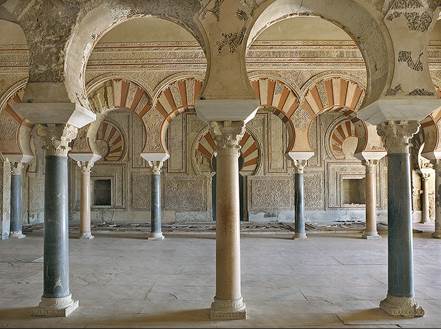
Fig. 373 – Salon Rico at Madinat al-Zahra (from 936 AD) (Zarateman; CC BY-SA 3.0)
Impressed by the splendor of the Caliphate, many Christians also saw the positives of Arab culture. In fact, many Christians, known as the Mozarabs, became culturally Arabized (although they had little interest in Islam). In 9th-century, the theologian Paul Alvarus (c. 800 – 861) even complained that the young Christians in Cordoba could no longer write Latin. He wrote:
The Christians love to read the poems and romances of the Arabs; they study the Arab theologians and philosophers, not to refute them but to form a correct and elegant Arabic. Where is the layman who now reads the Latin commentaries on the Holy Scriptures, or who studies the Gospels, prophets or apostles? Alas! All talented young Christians read and study with enthusiasm the Arab books; they gather immense libraries at great expense; they despise the Christian literature as unworthy of attention. They have forgotten their own language. For every one who can write a letter in Latin to a friend, there are a thousand who can express themselves in Arabic with elegance, and write better poems in this language than the Arabs themselves. [207]
Alvarus was one of the few Christians in the Caliphate of Cordoba who resisted Islam. In his works, he openly attacks the “traitors” among the clergy who worked with Muslim authorities and believed in coexistence. He was also good friends with the Christian martyr Monk Eulogius, who wrote a book describing in vivid detail how nearly fifty Christians were martyred between 851 and 859 when they proclaimed the divinity of Jesus and the falseness of the prophet of Islam. He was himself executed in 859. But interestingly, these martyrs were regularly seen as extremists, not only by the Muslims, but also by a large part of the Christians.
In 1085, the Christian king Alfonso VI (c. 1040–1109) reclaimed Toledo, in the middle of Spain. To their surprise, the liberators of Toledo found almost no Christians left in the city and those who remained couldn’t read Latin. Because of the vast libraries of Arabian books in the city, Toledo soon became the intellectual capital of Europe. It finally gave Europe access to the lost knowledge of Greece and also to the scientific and philosophical insights that the Arabs themselves generated.
Even when the Reconquista, the reconquering of Spain by the Christian kingdoms of Europe, took hold, the fascination with Arabic culture stayed. For instance, the tomb of Ferdinand III (c. 1200–1252), which was placed in the former Almohad mosque of Seville (of which only the tower still stands), has inscriptions in Arabic, Latin, Hebrew, and Castilian (see Fig. 374). [207]
A century later, around 1360, Peter of Castile (1334–1369), also known as Peter the Cruel, rebuilt the Alcazar, a former Muslim palace in Seville. For this project, he employed Muslim artists and craftsmen from Granada (see Fig. 375). Interestingly, we read on its walls in Arabic “There is no victor but Allah.” Similarly, the Jewish synagogue in Toledo includes verses from the Quran. And on a tombstone in the city, we read in Latin “In the name of our Lord Jesus Christ” and in Arabic “In the name of Allah, the Compassionate, the Merciful.” [190] And when the Muslims were ready to surrender Granada in 1492, the Catholic monarchs arrived in Granada in Moorish dress. Among the guests was Columbus, who would sail to America in that same year.
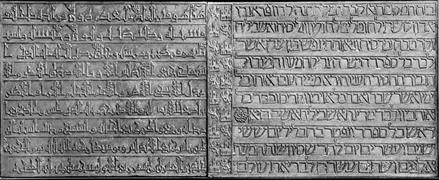
Fig. 374 – Arabic and Hebrew on the tomb of Ferdinand III (1252 AD) (T. Nickson, 2015)
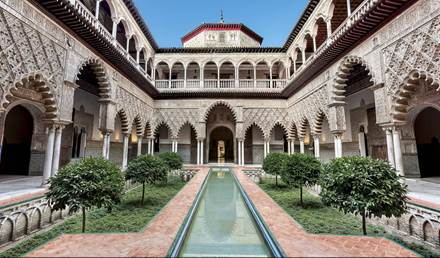
Fig. 375 – The Alcazar, built in Islamic style by the Christian monarch Peter of Castile (1360 AD)
The One Thousand and One Nights
Another famous product of the Islamic Golden Age is a collection of fantastical stories known as One Thousand and One Nights, which were told by professional storytellers as a form of entertainment. This happened first on the streets of Middle Eastern cities and later in Turkish coffee shops. The earliest reference to the collection is from the 10th century, when the work was still called The Thousand Nights. Over the centuries, more and more stories were added to the work. In many cases, these stories have been traced back to Arabic, Persian, Indian, Greek, Turkish, and Jewish folklore.
The book starts with King Shahriyar, who found out that his wife was having an affair with a black slave. Having lost his trust in women, he decided to marry a new virgin every morning and behead her the next day. To get the king back on the righteous path, the vizier’s daughter Scheherazade had a plan. She volunteered to spend the night with the king, telling him one of the captivating stories she had learned by reading “a thousand books of histories about antique races and departed rulers and the works of the poets [which she] knew by heart.” She made sure to stretch out the story till dawn, when story time ended. We then read:
But morning overtook Scheherazade, and she lapsed into silence. Then her sister said, “Sister, what an entertaining story!” Scheherazade replied, “What is this compared with what I shall tell you tomorrow night!” [208]
Wanting to hear the rest of the story, the king was forced to keep her alive for another night. She repeated this pattern 1001 times before running out of stories. By that time the king had fallen in love with her and was thus willing to spare her life and make her his queen.
The stories told by Scheherazade range from heroic adventures and moralistic wisdom literature to humorous tales and even stories with pornographic elements. The main characters are often royalty, including historical figures such as Caliph Harun Al-Rashid and his vizier Jafar al-Barmaki (767–803), but the stories also feature merchants, shop owners, innkeepers, dervishes, and lowlifes such as beggars and cunning criminals.
Many of the stories are full of magic, sorcerers, talking animals, and evil genies (djinn). In The Story of the Fisherman and the Djinn, a fisherman found a genie magically sealed in a copper container. Opening the seal, the genie appeared from behind plumes of smoke. When he discovered the demon was planning to kill him, the fisherman tricked the genie by asking him to prove he could fit inside such a small jar, after which he returned the seal and dumped the jar back into the sea. In another story, a terrifying black genie kept a woman locked in a glass chest with four metal locks to keep her chaste, but whenever he let her out and had a nap, she tricked nearby men into sleeping with her. Contrary to popular belief, magic carpets only make one small appearance in the Arabian Nights. We are told of a carpet that could instantly teleport its owner to wherever he wished to go.
In Europe, Aladdin’s Wonderful Lamp became the most popular of the stories, but this turned out to be a forgery added to the first European translation by Antoine Galland around the year 1700. Galland had heard the story from a contemporary Syrian storyteller called Hanna Diyab and had added it to the original medieval manuscript. In the century after, two Arabic versions of the story popped up, but it was later shown that these were forgeries as well, showing signs of being translated from French back into Arabic. Ali Baba and the Forty Thieves was another addition by Galland.
The end of the Islamic Golden Age
Many factors contributed to the end of the Islamic Golden Age. Already starting in 847, under Caliph al-Mutawakkil (822–861), the Islamic world took a more religiously conservative route, causing the House of Wisdom to decline. The polymath Al-Ghazali (c. 1058–1111) is also often associated with the fall of the Islamic Golden Age. In his Incoherence of the Philosophers, he complained that some of the Aristotelians, such as Ibn Sina, left God with almost nothing to do.[12] Al-Ghazali also believed that some ideas were so dangerous that philosophers holding these views should be killed, without even a chance to repent. This included assertions that the world is eternal instead of created, that God is not omniscient, and that there can exist more than one God.
On top of this, the Abbasid caliphate came under increasing attacks at its borders, and several Muslim states broke away from the empire. All these events weakened the empire’s economy. The biggest blow came in 1258 when the Mongols, under Hulagu Khan (c. 1217–1265), grandson of Genghis Khan (c. 1162–1227), sacked Baghdad. The Mongols were ferocious nomadic pony-riding fighters from the steppes of Central Asia, who established a vast empire from Hungary to China during the 13th and 14th centuries. When they entered Baghdad, they killed hundreds of thousands of people and destroyed the libraries. It was said at the time that the waters of the Tigris ran black with ink from the enormous quantities of books flung into the river and red from the blood of the scientists and philosophers.
Some scientific endeavors did continue well after the sack of Baghdad. The Mongols even hired the great Persian scientist al-Tusi (1201–1274) as an astrological advisor and Hulagu Khan funded an observatory in modern-day Azerbaijan. Yet the glory days of the Islamic Renaissance were over.

